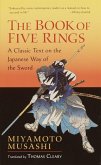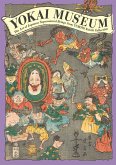Toby Slade
Japanese Fashion
Toby Slade
Japanese Fashion
- Broschiertes Buch
- Merkliste
- Auf die Merkliste
- Bewerten Bewerten
- Teilen
- Produkt teilen
- Produkterinnerung
- Produkterinnerung
Examines the entire sweep of Japanese clothing history, from the sophisticated fashion systems of late-Edo period kimonos onwards, providing possible theories of how Japan made this fashion journey and linking theories of fashion to the Japanese example. This book provides a full history of the last 200 years of Japanese clothing.
Andere Kunden interessierten sich auch für
![The Book of Five Rings The Book of Five Rings]() Miyamoto MusashiThe Book of Five Rings15,99 €
Miyamoto MusashiThe Book of Five Rings15,99 €![Yokai Museum Yokai Museum]() PIE BooksYokai Museum36,99 €
PIE BooksYokai Museum36,99 €![Bushido Bushido]() Inazo NitobeBushido23,99 €
Inazo NitobeBushido23,99 €![Japan Japan]() Keiko HirataJapan45,99 €
Keiko HirataJapan45,99 €![Yurei: The Japanese Ghost Yurei: The Japanese Ghost]() Zack DavissonYurei: The Japanese Ghost15,99 €
Zack DavissonYurei: The Japanese Ghost15,99 €![Fashion Victims Fashion Victims]() Alison Matthews David (Canada Toronto Metropolitan University)Fashion Victims22,99 €
Alison Matthews David (Canada Toronto Metropolitan University)Fashion Victims22,99 €![Take Ivy Take Ivy]() Shosuke IshizuTake Ivy37,99 €
Shosuke IshizuTake Ivy37,99 €-
-
-
Examines the entire sweep of Japanese clothing history, from the sophisticated fashion systems of late-Edo period kimonos onwards, providing possible theories of how Japan made this fashion journey and linking theories of fashion to the Japanese example. This book provides a full history of the last 200 years of Japanese clothing.
Produktdetails
- Produktdetails
- Verlag: Bloomsbury Specialist
- Artikelnr. des Verlages: 20280
- Seitenzahl: 230
- Erscheinungstermin: 1. November 2009
- Englisch
- Abmessung: 234mm x 156mm x 13mm
- Gewicht: 384g
- ISBN-13: 9781847882523
- ISBN-10: 1847882528
- Artikelnr.: 25903395
- Herstellerkennzeichnung
- Libri GmbH
- Europaallee 1
- 36244 Bad Hersfeld
- gpsr@libri.de
- Verlag: Bloomsbury Specialist
- Artikelnr. des Verlages: 20280
- Seitenzahl: 230
- Erscheinungstermin: 1. November 2009
- Englisch
- Abmessung: 234mm x 156mm x 13mm
- Gewicht: 384g
- ISBN-13: 9781847882523
- ISBN-10: 1847882528
- Artikelnr.: 25903395
- Herstellerkennzeichnung
- Libri GmbH
- Europaallee 1
- 36244 Bad Hersfeld
- gpsr@libri.de
Toby Slade has a Ph.D. in Art History and Theory from Sydney University, where his main area of research was Japanese fashion. He has taught fashion history at the University of Technology Sydney and is currently lecturing in fashion theory at Keio University in Tokyo.
1. Introduction: Modernity, Fashion and Japan
Modernity and Modernity in Clothing
Global Fashion and National Cultures
Japan
2. Japanese Clothes 1800-2000
Clothing in the Edo Period
Nakedness and Covering It
Decency
Foundation Choices: Yoga and Nihonga
Materials and Materialism
'Westernisation' and Japanese Fashion
Textile Industrialisation
The Democratisation of Consumption
World War II
The Rise of Designers
Today's Subcultures
3. Japanese Menswear: Masculinity and Sartorial Statecraft
Uniforms and the State: The Emperor's New Clothes
Suits: Modern and Classic Masculinity
The Suit in Europe and America
The Growing Civilised Centre
The Japanese Suit
The Rokumeikan
Modern Boys
Possible Masculinities post 2000
4. Japanese Womenswear: Femininity and Modernity
Traditional Notions of Sartorial Womanhood
Meiji Girl Students and School Uniforms
Taisho Decadence and the Moga
Sportswear, Swimwear & Movement
Cosmetics and Substance
Hairstyles: The First Experiments
Kimono Reform and Traditional Identity
Feminine Formality and Time
1960s Counter Culture in Japan
Japanese Femininity Today
5. Conclusions: Theories of Japanese Fashion
The Economics of Aesthetics
A Set of Reoccurring Questions
Functional Explanations
Fashion as the Search for Meaning and/or Identity
Fashion and the Struggle for Status
The Economics of Fashion
Fashion as Communication
Dynamic Explanations of Fashion
Fashion as Diffusion
Cycles of Fashion
Fashion as Erotic
Fashion and the Zeitgeist
Fashion as Aesthetics
Acknowledgements
Bibliography
Modernity and Modernity in Clothing
Global Fashion and National Cultures
Japan
2. Japanese Clothes 1800-2000
Clothing in the Edo Period
Nakedness and Covering It
Decency
Foundation Choices: Yoga and Nihonga
Materials and Materialism
'Westernisation' and Japanese Fashion
Textile Industrialisation
The Democratisation of Consumption
World War II
The Rise of Designers
Today's Subcultures
3. Japanese Menswear: Masculinity and Sartorial Statecraft
Uniforms and the State: The Emperor's New Clothes
Suits: Modern and Classic Masculinity
The Suit in Europe and America
The Growing Civilised Centre
The Japanese Suit
The Rokumeikan
Modern Boys
Possible Masculinities post 2000
4. Japanese Womenswear: Femininity and Modernity
Traditional Notions of Sartorial Womanhood
Meiji Girl Students and School Uniforms
Taisho Decadence and the Moga
Sportswear, Swimwear & Movement
Cosmetics and Substance
Hairstyles: The First Experiments
Kimono Reform and Traditional Identity
Feminine Formality and Time
1960s Counter Culture in Japan
Japanese Femininity Today
5. Conclusions: Theories of Japanese Fashion
The Economics of Aesthetics
A Set of Reoccurring Questions
Functional Explanations
Fashion as the Search for Meaning and/or Identity
Fashion and the Struggle for Status
The Economics of Fashion
Fashion as Communication
Dynamic Explanations of Fashion
Fashion as Diffusion
Cycles of Fashion
Fashion as Erotic
Fashion and the Zeitgeist
Fashion as Aesthetics
Acknowledgements
Bibliography
1. Introduction: Modernity, Fashion and Japan
Modernity and Modernity in Clothing
Global Fashion and National Cultures
Japan
2. Japanese Clothes 1800-2000
Clothing in the Edo Period
Nakedness and Covering It
Decency
Foundation Choices: Yoga and Nihonga
Materials and Materialism
'Westernisation' and Japanese Fashion
Textile Industrialisation
The Democratisation of Consumption
World War II
The Rise of Designers
Today's Subcultures
3. Japanese Menswear: Masculinity and Sartorial Statecraft
Uniforms and the State: The Emperor's New Clothes
Suits: Modern and Classic Masculinity
The Suit in Europe and America
The Growing Civilised Centre
The Japanese Suit
The Rokumeikan
Modern Boys
Possible Masculinities post 2000
4. Japanese Womenswear: Femininity and Modernity
Traditional Notions of Sartorial Womanhood
Meiji Girl Students and School Uniforms
Taisho Decadence and the Moga
Sportswear, Swimwear & Movement
Cosmetics and Substance
Hairstyles: The First Experiments
Kimono Reform and Traditional Identity
Feminine Formality and Time
1960s Counter Culture in Japan
Japanese Femininity Today
5. Conclusions: Theories of Japanese Fashion
The Economics of Aesthetics
A Set of Reoccurring Questions
Functional Explanations
Fashion as the Search for Meaning and/or Identity
Fashion and the Struggle for Status
The Economics of Fashion
Fashion as Communication
Dynamic Explanations of Fashion
Fashion as Diffusion
Cycles of Fashion
Fashion as Erotic
Fashion and the Zeitgeist
Fashion as Aesthetics
Acknowledgements
Bibliography
Modernity and Modernity in Clothing
Global Fashion and National Cultures
Japan
2. Japanese Clothes 1800-2000
Clothing in the Edo Period
Nakedness and Covering It
Decency
Foundation Choices: Yoga and Nihonga
Materials and Materialism
'Westernisation' and Japanese Fashion
Textile Industrialisation
The Democratisation of Consumption
World War II
The Rise of Designers
Today's Subcultures
3. Japanese Menswear: Masculinity and Sartorial Statecraft
Uniforms and the State: The Emperor's New Clothes
Suits: Modern and Classic Masculinity
The Suit in Europe and America
The Growing Civilised Centre
The Japanese Suit
The Rokumeikan
Modern Boys
Possible Masculinities post 2000
4. Japanese Womenswear: Femininity and Modernity
Traditional Notions of Sartorial Womanhood
Meiji Girl Students and School Uniforms
Taisho Decadence and the Moga
Sportswear, Swimwear & Movement
Cosmetics and Substance
Hairstyles: The First Experiments
Kimono Reform and Traditional Identity
Feminine Formality and Time
1960s Counter Culture in Japan
Japanese Femininity Today
5. Conclusions: Theories of Japanese Fashion
The Economics of Aesthetics
A Set of Reoccurring Questions
Functional Explanations
Fashion as the Search for Meaning and/or Identity
Fashion and the Struggle for Status
The Economics of Fashion
Fashion as Communication
Dynamic Explanations of Fashion
Fashion as Diffusion
Cycles of Fashion
Fashion as Erotic
Fashion and the Zeitgeist
Fashion as Aesthetics
Acknowledgements
Bibliography
1. Introduction: Modernity, Fashion and Japan
Modernity and Modernity in Clothing
Global Fashion and National Cultures
Japan
2. Japanese Clothes 1800-2000
Clothing in the Edo Period
Nakedness and Covering It
Decency
Foundation Choices: Yoga and Nihonga
Materials and Materialism
'Westernisation' and Japanese Fashion
Textile Industrialisation
The Democratisation of Consumption
World War II
The Rise of Designers
Today's Subcultures
3. Japanese Menswear: Masculinity and Sartorial Statecraft
Uniforms and the State: The Emperor's New Clothes
Suits: Modern and Classic Masculinity
The Suit in Europe and America
The Growing Civilised Centre
The Japanese Suit
The Rokumeikan
Modern Boys
Possible Masculinities post 2000
4. Japanese Womenswear: Femininity and Modernity
Traditional Notions of Sartorial Womanhood
Meiji Girl Students and School Uniforms
Taisho Decadence and the Moga
Sportswear, Swimwear & Movement
Cosmetics and Substance
Hairstyles: The First Experiments
Kimono Reform and Traditional Identity
Feminine Formality and Time
1960s Counter Culture in Japan
Japanese Femininity Today
5. Conclusions: Theories of Japanese Fashion
The Economics of Aesthetics
A Set of Reoccurring Questions
Functional Explanations
Fashion as the Search for Meaning and/or Identity
Fashion and the Struggle for Status
The Economics of Fashion
Fashion as Communication
Dynamic Explanations of Fashion
Fashion as Diffusion
Cycles of Fashion
Fashion as Erotic
Fashion and the Zeitgeist
Fashion as Aesthetics
Acknowledgements
Bibliography
Modernity and Modernity in Clothing
Global Fashion and National Cultures
Japan
2. Japanese Clothes 1800-2000
Clothing in the Edo Period
Nakedness and Covering It
Decency
Foundation Choices: Yoga and Nihonga
Materials and Materialism
'Westernisation' and Japanese Fashion
Textile Industrialisation
The Democratisation of Consumption
World War II
The Rise of Designers
Today's Subcultures
3. Japanese Menswear: Masculinity and Sartorial Statecraft
Uniforms and the State: The Emperor's New Clothes
Suits: Modern and Classic Masculinity
The Suit in Europe and America
The Growing Civilised Centre
The Japanese Suit
The Rokumeikan
Modern Boys
Possible Masculinities post 2000
4. Japanese Womenswear: Femininity and Modernity
Traditional Notions of Sartorial Womanhood
Meiji Girl Students and School Uniforms
Taisho Decadence and the Moga
Sportswear, Swimwear & Movement
Cosmetics and Substance
Hairstyles: The First Experiments
Kimono Reform and Traditional Identity
Feminine Formality and Time
1960s Counter Culture in Japan
Japanese Femininity Today
5. Conclusions: Theories of Japanese Fashion
The Economics of Aesthetics
A Set of Reoccurring Questions
Functional Explanations
Fashion as the Search for Meaning and/or Identity
Fashion and the Struggle for Status
The Economics of Fashion
Fashion as Communication
Dynamic Explanations of Fashion
Fashion as Diffusion
Cycles of Fashion
Fashion as Erotic
Fashion and the Zeitgeist
Fashion as Aesthetics
Acknowledgements
Bibliography
1. Introduction: Modernity, Fashion and Japan
Modernity and Modernity in Clothing
Global Fashion and National Cultures
Japan
2. Japanese Clothes 1800-2000
Clothing in the Edo Period
Nakedness and Covering It
Decency
Foundation Choices: Yoga and Nihonga
Materials and Materialism
'Westernisation' and Japanese Fashion
Textile Industrialisation
The Democratisation of Consumption
World War II
The Rise of Designers
Today's Subcultures
3. Japanese Menswear: Masculinity and Sartorial Statecraft
Uniforms and the State: The Emperor's New Clothes
Suits: Modern and Classic Masculinity
The Suit in Europe and America
The Growing Civilised Centre
The Japanese Suit
The Rokumeikan
Modern Boys
Possible Masculinities post 2000
4. Japanese Womenswear: Femininity and Modernity
Traditional Notions of Sartorial Womanhood
Meiji Girl Students and School Uniforms
Taisho Decadence and the Moga
Sportswear, Swimwear & Movement
Cosmetics and Substance
Hairstyles: The First Experiments
Kimono Reform and Traditional Identity
Feminine Formality and Time
1960s Counter Culture in Japan
Japanese Femininity Today
5. Conclusions: Theories of Japanese Fashion
The Economics of Aesthetics
A Set of Reoccurring Questions
Functional Explanations
Fashion as the Search for Meaning and/or Identity
Fashion and the Struggle for Status
The Economics of Fashion
Fashion as Communication
Dynamic Explanations of Fashion
Fashion as Diffusion
Cycles of Fashion
Fashion as Erotic
Fashion and the Zeitgeist
Fashion as Aesthetics
Acknowledgements
Bibliography
Modernity and Modernity in Clothing
Global Fashion and National Cultures
Japan
2. Japanese Clothes 1800-2000
Clothing in the Edo Period
Nakedness and Covering It
Decency
Foundation Choices: Yoga and Nihonga
Materials and Materialism
'Westernisation' and Japanese Fashion
Textile Industrialisation
The Democratisation of Consumption
World War II
The Rise of Designers
Today's Subcultures
3. Japanese Menswear: Masculinity and Sartorial Statecraft
Uniforms and the State: The Emperor's New Clothes
Suits: Modern and Classic Masculinity
The Suit in Europe and America
The Growing Civilised Centre
The Japanese Suit
The Rokumeikan
Modern Boys
Possible Masculinities post 2000
4. Japanese Womenswear: Femininity and Modernity
Traditional Notions of Sartorial Womanhood
Meiji Girl Students and School Uniforms
Taisho Decadence and the Moga
Sportswear, Swimwear & Movement
Cosmetics and Substance
Hairstyles: The First Experiments
Kimono Reform and Traditional Identity
Feminine Formality and Time
1960s Counter Culture in Japan
Japanese Femininity Today
5. Conclusions: Theories of Japanese Fashion
The Economics of Aesthetics
A Set of Reoccurring Questions
Functional Explanations
Fashion as the Search for Meaning and/or Identity
Fashion and the Struggle for Status
The Economics of Fashion
Fashion as Communication
Dynamic Explanations of Fashion
Fashion as Diffusion
Cycles of Fashion
Fashion as Erotic
Fashion and the Zeitgeist
Fashion as Aesthetics
Acknowledgements
Bibliography
Slade sets himself very ambitious targets in Japanese Fashion: A Cultural History, an analytical survey of a whole clothing culture, which he successfully meets. Dr. Slade is an imaginative historian who has the ability to synthesize a wide range of sources, ranging from the offical record to the ephemeral and teh vernacular. Peter McNeil, Fashion Theory: Volume 14, Issue 4








